Let’s elevate your automated welding event together.
Contact us ahead of your next tradeshow or event to secure the use of Tregaskiss® robotic, fixed automatic, or cobot MIG welding guns, robotic nozzle cleaning stations, and more – at no cost!
Contact us ahead of your next tradeshow or event to secure the use of Tregaskiss® robotic, fixed automatic, or cobot MIG welding guns, robotic nozzle cleaning stations, and more – at no cost!
Your safety is our priority. Read the below safety precautions to make sure you are always safe on the job.

Protect yourself and others from injury — read, follow, and save these important safety precautions and operating instructions.

DANGER! Indicates a hazardous situation which, if not avoided, will result in death or serious injury. The possible hazards are shown in the adjoining symbols or explained in the text.

Indicates a hazardous situation which, if not avoided, could result in death or serious injury. The possible hazzards are shown in the adjoining symbols or explained in the text.
NOTICE: Indicates statements not related to personal injury.

This group of symbols means Warning! Watch Out! ELECTRIC SHOCK, MOVING PARTS, and HOT PARTS hazards. Consult symbols and related instructions below for necessary actions to avoid these hazards.

The symbols shown below are used throughout this manual to call attention to and identify possible hazards. When you see the symbol, watch out, and follow the related instructions to avoid the hazard. The safety information given below is only a summary of the more complete safety information found in the Principal Safety Standards listed in Section 1-4, and in welding power source Owner’s Manual. Read and follow all Safety Standards.

Only qualified persons should install, operate, maintain, and repair this equipment. A qualified person is defined as one who, by possession of a recognized degree, certificate, or professional standing, or who by extensive knowledge, training and experience, has successfully demonstrated ability to solve or resolve problems relating to the subject matter, the work, or the project and has received safety training to recognize and avoid the hazards involved.

During operation, keep everybody, especially children, away.






Arc rays from the welding process produce intense visible and invisible (ultraviolet and infrared) rays that can burn eyes and skin. Sparks fly off from the weld.


Noise from some processes or equipment can damage hearing.



Safety in Welding, Cutting, and Allied Processes, American Welding Society standard ANSI Standard Z49.1. Website: http://www.aws.org.
Safe Practice For Occupational And Educational Eye And Face Protection, ANSI Standard Z87.1, from American National Standards Institute. Website: www.ansi.org.
Safe Practices for the Preparation of Containers and Piping for Welding and Cutting, American Welding Society Standard AWS F4.1 from Global Engineering Documents. Website: www.global.ihs.com.
Safe Practices for Welding and Cutting Containers that have Held Combustibles, American Welding Society Standard AWS A6.0 from Global Engineering Documents. Website: www.global.ihs.com.
National Electrical Code, NFPA Standard 70 from National Fire Protection Association. Website: www.nfpa.org and www.sparky.org.
Safe Handling of Compressed Gases in Cylinders, CGA Pamphlet P-1 from Compressed Gas Association. Website: www.cganet.com.
Safety in Welding, Cutting, and Allied Processes, CSA Standard W117.2 from Canadian Standards Association. Website: www. csagroup.org.
Standard for Fire Prevention During Welding, Cutting, and Other Hot Work, NFPA Standard 51B from National Fire Protection Association. Website: www.nfpa.org.
OSHA, Occupational Safety and Health Standards for General Industry, Title 29, Code of Federal Regulations (CFR), Part 1910.177 Subpart N, Part 1910 Subpart Q, and Part 1926, Subpart J. Website: www.osha.gov.
SR7 2020–02
Electric current flowing through any conductor causes localized electric and magnetic fields (EMF). The current from arc welding (and allied processes including spot welding, gouging, plasma arc cutting, and induction heating operations) creates an EMF field around the welding circuit. EMF fields can interfere with some medical implants, e. g. pacemakers. Protective measures for persons wearing medical implants have to be taken. For example, restrict access for passers−by or conduct individual risk assessment for welders. All welders should use the following procedures in order to minimize exposure to EMF fields from the welding circuit:
Implanted Medical Device wearers should consult their doctor and the device manufacturer before performing or going near arc welding, spot welding, gouging, plasma arc cutting, or induction heating operations. If cleared by your doctor, then following the above procedures is recommended.


DANGER! – Indique une situation dangereuse qui si on l’évite pas peut donner la mort ou des blessures graves. Les dangers possibles sont montrés par les symboles joints ou sont expliqués dans le texte.

Indique une situation dangereuse qui si on l’évite pas peut donner la mort ou des blessures graves. Les dangers possibles sont montrés par les symboles joints ou sont expliqués dans le texte.
AVIS – Indique des déclarations pas en relation avec des blessures personnelles.

Ce groupe de symboles veut dire Avertissement! Attention! DANGER DE CHOC ELECTRIQUE, PIECES EN MOUVEMENT, et PIECES CHAUDES. Reportez-vous aux symboles et aux directives cidessous afin de connaître les mesures à prendre pour éviter tout danger.

Les symboles présentés ci-après sont utilisés tout au long du présent manuel pour attirer votre attention et identifier les risques de danger. Lorsque vous voyez un symbole, soyez vigilant et suivez les directives mentionnées afin d’éviter tout danger. Les consignes de sécurité présentées ci-après ne font que résumer les informations contenues dans les principales normes de sécurité énumérées à la section 1-4 et manuel d’utilisation du poste de soudage. Veuillez lire et respecter toutes ces normes de sécurité.

L’installation, l’utilisation, l’entretien et les réparations ne doivent être confiés qu’à des personnes qualifiées. Une personne qualifiée est définie comme celle qui, par la possession d’un diplôme reconnu, d’un certificat ou d’un statut professionnel, ou qui, par une connaissance, une formation et une expérience approfondies, a démontré avec succès sa capacité à résoudre les problèmes liés à la tâche, le travail ou le projet et a reçu une formation en sécurité afin de reconnaître et d’éviter les risques inhérents

Au cours de l’utilisation, tenir toute personne à l’écart et plus particulièrement les enfants.






Le rayonnement de l’arc du procédé de soudage génère des rayons visibles et invisibles intenses (ultraviolets et infrarouges) susceptibles de provoquer des brûlures dans les yeux et sur la peau. Des étincelles sont projetées pendant le soudage.


Le bruit des processus et des équipements peut affecter l’ouïe



Safety in Welding, Cutting, and Allied Processes, American Welding Society standard ANSI Standard Z49.1. Website: http://www.aws.org.
Safe Practice For Occupational And Educational Eye And Face Pro- tection, ANSI Standard Z87.1, from American National Standards Institute. Website: www.ansi.org.
Safe Practices for the Preparation of Containers and Piping for Welding and Cutting, American Welding Society Standard AWS F4.1 from Global Engineering Documents. Website: www.global.ihs.com.
Safe Practices for Welding and Cutting Containers that have Held Combustibles, American Welding Society Standard AWS A6.0 from Global Engineering Documents. Website: www.global.ihs.com.
National Electrical Code, NFPA Standard 70 from National Fire Protection Association. Website: www.nfpa.org and www.sparky.org.
Safe Handling of Compressed Gases in Cylinders, CGA Pamphlet P-1 from Compressed Gas Association. Website: www.cganet.com.
Safety in Welding, Cutting, and Allied Processes, CSA Standard W117.2 from Canadian Standards Association. Website: www. csagroup.org.
Standard for Fire Prevention During Welding, Cutting, and Other Hot Work, NFPA Standard 51B from National Fire Protection Association. Website: www.nfpa.org.
OSHA, Occupational Safety and Health Standards for General Industry, Title 29, Code of Federal Regulations (CFR), Part 1910.177 Sub- part N, Part 1910 Subpart Q, and Part 1926, Subpart J. Website: www.osha.gov.
SR7_fre 2020–02
Le courant électrique qui traverse tout conducteur génère des champs électromagnétiques (CEM) à certains endroits. Le courant issu d’un soudage à l’arc (et de procédés connexes, y compris le soudage par points, le gougeage, le découpage plasma et les opérations de chauffage par induction) crée un champ électromagnétique (CEM) autour du circuit de soudage. Les champs électromagnétiques produits peuvent causer interférence à certains implants médicaux, ex. les stimulateurs cardiaques. Des mesures de protection pour les porteurs d’implants médicaux doivent être prises: par exemple, des restrictions d’accès pour les passants ou une évaluation individuelle des risques pour les soudeurs. Tous les soudeurs doivent appliquer les procédures suivantes pour minimiser l’exposition aux CEM provenant du circuit de soudage:
Les porteurs d’implants doivent d’abord consulter leur médecin avant de s’approcher des opérations de soudage à l’arc, de soudage par points, de gougeage, du coupage plasma ou de chauffage par induction. Si le médecin approuve, il est recommandé de suivre les procédures précédentes.

PELIGRO! – Indica una situación peligrosa que, si no se laevita, resultará en muerte o lesión grave. Los peligros posibles se muestran en los símbolos adjuntos o se explican en el texto.

Indica una situación peligrosa que, si no se la evita, podría resultar en muerte o lesión grave. Los peligros posibles se muestran en los símbolos adjuntos, o se explican en el texto.
AVISO – Indica precauciones no relacionadas a lesiones personales.

Este grupo de símbolos significa ¡Advertencia!, ¡Cuidado! CHOQUE O DESCARGA ELÉCTRICA, PIEZAS QUE SE MUEVEN, y peligros de PARTES CALIENTES. Consulte los símbolos y las instrucciones relacionadas que aparecen a continuación para ver las acciones necesarias para evitar estos peligros

Se usan los símbolos mostrados abajo por todo éste manual para llamar la atención e identificar a peligros posibles. Cuando usted vea este símbolo, tenga cuidado, y siga a las instrucciones relacionadas para evitar el peligro. La información de seguridad dada abajo es solamente un resumen de la información más completa de seguridad que se encuentra en los estándares principales de seguridad de sección 1-4, y en el Manual del Operario de la fuente de poder de soldadura. Lea y siga todas los estándares de seguridad.

Solamente personal cualificado debe instalar, utilizar, mantener y reparar este equipo. La definición de personal cualificado es cualquier persona que, debido a que posee un título, un certificado o una posición profesional reconocida, o gracias a su gran conocimiento, capacitación y experiencia, haya demostrado con éxito la capacidad para solucionar o resolver problemas relacionados con el trabajo, el proyecto o el tema en cuestión, además de haber asistido a una capacitación en seguridad para reconocer y evitar los peligros que implica el proceso.

Durante su operación mantenga lejos a todos, especialmente a los niños






Los rayos del arco de un proceso de suelda producen un calor intenso y rayos ultravioletas fuertes que pueden quemar los ojos y la piel. Las chispas se escapan de la soldadura.


Ruido proveniente de algunos procesos o equipo puede dañar el oído



Safety in Welding, Cutting, and Allied Processes, American Welding Society standard ANSI Standard Z49.1. Website: http://www.aws.org.
Safe Practice For Occupational And Educational Eye And Face Protection, ANSI Standard Z87.1, from American National Standards Institute. Website: www.ansi.org.
Safe Practices for the Preparation of Containers and Piping for Welding and Cutting, American Welding Society Standard AWS F4.1 from Global Engineering Documents. Website: www.global.ihs.com.
Safe Practices for Welding and Cutting Containers that have Held Combustibles, American Welding Society Standard AWS A6.0 from Global Engineering Documents. Website: www.global.ihs.com.
National Electrical Code, NFPA Standard 70 from National Fire Protection Association. Website: www.nfpa.org and www.sparky.org.
Safe Handling of Compressed Gases in Cylinders, CGA Pamphlet P-1 from Compressed Gas Association. Website: www.cganet.com.
Safety in Welding, Cutting, and Allied Processes, CSA Standard W117.2 from Canadian Standards Association. Website: www. csagroup.org.
Standard for Fire Prevention During Welding, Cutting, and Other Hot Work, NFPA Standard 51B from National Fire Protection Association. Website: www.nfpa.org.
OSHA, Occupational Safety and Health Standards for General Industry, Title 29, Code of Federal Regulations (CFR), Part 1910.177 Subpart N, Part 1910 Subpart Q, and Part 1926, Subpart J. Website: www.osha.gov.
SR7_spa 2020–02
La corriente que fluye a través de un conductor genera campos eléctricos y magnéticos (EMF) localizados. La corriente del arco de soldadura (y otras técnicas afines como la soldadura por puntos, el ranurado, el corte por plasma y el calentamiento por inducción) genera un campo EMF alrededor del circuito de soldadura. Los campos EMF pueden interferir con algunos dispositivos médicos implantados como, por ejemplo, los marcapasos. Por lo tanto, se deben tomar medidas de protección para las personas que utilizan estos implantes médicos. Por ejemplo, aplique restricciones al acceso de personas que pasan por las cercanías o realice evaluaciones de riesgo individuales para los soldadores. Todos los soldadores deben seguir los procedimientos que se indican a continuación con el objeto de minimizar la exposición a los campos EMF generados por el circuito de soldadura:
Las personas que usen aparatos médico implantados deben consultar con su médico y el fabricante del aparato antes de llevar a cabo o acercarse a soldadura de arco, soldadura de punto, ranurar, hacer corte por plasma, u operaciones de calentamiento por inducción. Si su doctor lo permite, entonces siga los procedimientos de arriba.

A directory for all how-to videos and step-by-step guides for Bernard® and Tregaskiss® MIG welding products.
![]()
![]() How to install a Bernard AccuLock™ S Liner
How to install a Bernard AccuLock™ S Liner
![]() How to change Bernard®AccuLock™ S Consumables (with set screw power pin cap) on a BTB MIG gun
How to change Bernard®AccuLock™ S Consumables (with set screw power pin cap) on a BTB MIG gun
![]() How to change Bernard®AccuLock™ S Consumables (without set screw power pin cap) on a BTB MIG gun
How to change Bernard®AccuLock™ S Consumables (without set screw power pin cap) on a BTB MIG gun
![]() How to upgrade a Bernard® Conventional Liner to AccuLock™ S Dual Locked Liner
How to upgrade a Bernard® Conventional Liner to AccuLock™ S Dual Locked Liner
![]()
![]() How to install or replace a conventional liner
How to install or replace a conventional liner
![]()
![]() How to trim a conventional liner
How to trim a conventional liner
![]()
![]() How to upgrade from a conventional liner to a QUICK LOAD® Liner
How to upgrade from a conventional liner to a QUICK LOAD® Liner
![]()
![]() How to install or replace a liner when using a Centerfire™ or a Quik Tip™ Diffuser with the new internal stop
How to install or replace a liner when using a Centerfire™ or a Quik Tip™ Diffuser with the new internal stop
![]()
![]() How to change a conventional liner on guns equipped with wire brake
How to change a conventional liner on guns equipped with wire brake
![]()
![]() How to install an aluminum liner on MIG guns equipped with wire brake
How to install an aluminum liner on MIG guns equipped with wire brake
![]()
![]() How to install or replace a liner
How to install or replace a liner
![]()
![]() How to install or replace a rotatable neck
How to install or replace a rotatable neck
![]()
![]() How to install or replace a fixed neck on a gun with a T Series Large Straight Handle
How to install or replace a fixed neck on a gun with a T Series Large Straight Handle
![]()
![]() How to install or replace a fixed neck on a gun with a T Series Small Straight Handle
How to install or replace a fixed neck on a gun with a T Series Small Straight Handle
![]()
![]() How to install or replace a fixed neck on a gun with a B or O Series Curved Handle
How to install or replace a fixed neck on a gun with a B or O Series Curved Handle
![]()
![]() How to change a fixed neck to a rotatable neck
How to change a fixed neck to a rotatable neck
![]()
![]() How to replace a T Series Handle switch
How to replace a T Series Handle switch
![]()
![]() How to install or replace a Universal Power Pin
How to install or replace a Universal Power Pin
![]()
![]() How to replace a Miller® Power Pin
How to replace a Miller® Power Pin
![]()
![]() How to install or replace a Euro Power Pin
How to install or replace a Euro Power Pin
![]()
![]() How to install or replace a Bernard™ Quick Disconnect
How to install or replace a Bernard™ Quick Disconnect
![]()
![]() How to repair the cable on a gun with a T Series Large Straight Handle
How to repair the cable on a gun with a T Series Large Straight Handle
![]()
![]() How to repair the cable on a gun with a T Series Small Straight Handle
How to repair the cable on a gun with a T Series Small Straight Handle
![]()
![]() How to replace an LSR Unicable
How to replace an LSR Unicable
![]()
![]() How to install an LSR Unicable
How to install an LSR Unicable
![]()
![]() How to install an LSR Unicable Extension
How to install an LSR Unicable Extension
![]()
![]() How to install the Dual Shunt Kit (5800)
How to install the Dual Shunt Kit (5800)
![]()
![]() How to install front-end Air Blast for TOUGH GUN® ThruArm™ Series MIG Guns
How to install front-end Air Blast for TOUGH GUN® ThruArm™ Series MIG Guns
![]()
![]() How to install the LSR Flange on an ABB® Robot
How to install the LSR Flange on an ABB® Robot
![]()
![]() How to install the LSR Flange on an OTC Daihen® Robot
How to install the LSR Flange on an OTC Daihen® Robot
![]()
![]() How to install a TOUGH GUN® ThruArm™ Robotic MIG Gun onto a Motoman® Robot
How to install a TOUGH GUN® ThruArm™ Robotic MIG Gun onto a Motoman® Robot
![]()
![]() How to install a TOUGH GUN® TA3 MIG Gun onto a Panasonic® Robot
How to install a TOUGH GUN® TA3 MIG Gun onto a Panasonic® Robot
![]()
![]() How to install a TOUGH GUN® ThruArm™ MIG Gun equipped with TOUGH GUN I.C.E.® Technology onto a KUKA® Robot
How to install a TOUGH GUN® ThruArm™ MIG Gun equipped with TOUGH GUN I.C.E.® Technology onto a KUKA® Robot
![]()
![]() How to install the TOUGH GUN® TT3 Reamer
How to install the TOUGH GUN® TT3 Reamer
![]()
![]() How to install the TT3-500R sprayer valve retrofit kit
How to install the TT3-500R sprayer valve retrofit kit
![]()
![]() How to install the TOUGH GUN® Wire Cutter
How to install the TOUGH GUN® Wire Cutter
![]()
![]() How to install the Filter/Regulator unit
How to install the Filter/Regulator unit
![]()
![]() How to change the 4-sided v-block
How to change the 4-sided v-block
![]()
![]() How to replace the cutter blade
How to replace the cutter blade
![]()
![]() How to replace a spindle on a TOUGH GUN® Reamer
How to replace a spindle on a TOUGH GUN® Reamer
![]()
![]() How to replace the circuit board
How to replace the circuit board
![]()
![]() How to replace the clamp limit switch
How to replace the clamp limit switch
![]()
![]() How to remove the motor and replace the belt
How to remove the motor and replace the belt
![]()
![]() How to replace the upper and lower limit switches for the spindle
How to replace the upper and lower limit switches for the spindle
![]()
![]() How to install the TT3-NOZ external nozzle detection (Home Interrupt version)
How to install the TT3-NOZ external nozzle detection (Home Interrupt version)
![]()
![]() How to install the TT3-500 TOUGH GUN® Sprayer
How to install the TT3-500 TOUGH GUN® Sprayer
![]()
![]() How to mount the SR-500 Sprayer
How to mount the SR-500 Sprayer
![]()
![]() How to install the TOUGH GUN® Reamer Stand
How to install the TOUGH GUN® Reamer Stand
![]()
![]() How to install the TOUGH GARD® Multi-Feed System to the TOUGH GUN® Reamer
How to install the TOUGH GARD® Multi-Feed System to the TOUGH GUN® Reamer

Tregaskiss and Bernard spec sheet and owner’s manuals provide part numbers, installation and maintenance information, technical data, exploded views, parts breakdowns, troubleshooting and ordering information for MIG gun consumables, welding guns and peripherals.
Find what you’re looking for below.
SP-ALS AccuLock™ S Consumables spec sheet
SP-ALR AccuLock R Consumables spec sheet
SP-TLC TOUGH LOCK® Consumables spec sheet
SP-CFC Centerfire™ Consumables spec sheet
SP-QTC Quik Tip™ Consumables spec sheet
SP-EL Elliptical Consumables spec sheet
SP-DF spec sheet
SP-IP spec sheet
OM-IP owner’s manual
(for conventional style robots)
(for through-arm style robots)
SP-TA3 spec sheet
OM-TA3-A owner’s manual
OM-TA3-F owner’s manual (for FANUC® robots)
M076 Addendum (air blast installation)
M079 Addendum (wire lead installation; clutch mount)
(for conventional style robots)
SP-TT4 TOUGH GUN TT4A and TT4E Reamer spec sheet
OM-TT4A TOUGH GUN TT4A owner’s manual
OM-TT4E TOUGH GUN TT4E owner’s manual
OM-WC4 TOUGH GUN Wire Cutter owner’s manual (Compatible with TT4A, TT4E)
OM-TT3 TOUGH GUN TT3 Reamer owner’s manual
OM-TT3E TOUGH GUN TT3E Reamer owner’s manual
OM-WC TOUGH GUN Wire Cutter owner’s manual (Compatible with TT3A, TT3E)
M027 TOUGH GUN Sprayer owner’s manual (RS-500, TS-500)
OM-NCF TOUGH GUN Neck Checking Fixture owner’s manual
M028 TOUGH GUN Clutch owner’s manual
SP-QLL QUICK LOAD Liners and AutoLength Pins spec sheet
SP-PPK Bernard® Power Pins spec sheet
SP-TPP Tregaskiss® Power Pins spec sheet
SP-QCB Quick-Connect Blocks and Adaptors spec sheet
SP-BCP Bernard Control Plugs spec sheet
SP-TCP Tregaskiss Control Plugs spec sheet
SP-DFB-ADAPTOR Bernard Quick-Disconnect Adaptor Kits spec sheet
SP-N Bernard Necks spec sheet (for BTB MIG guns)
SP-FN Bernard Flex Necks spec sheet (for curved handle MIG guns)
SP-NC Bernard Q-Neck Coupler and Q-Neck Grip spec sheet
SP-SGA Spool Gun and Push-Pull Gun Conversion Kits spec sheet
Which kind of product do you want to identify?
How is your gun positioned relative to the weld?
How is your semi-automatic MIG gun cooled?
Your MIG gun neck is the easiest way to visually identify your product. Which of the following does your MIG gun look like?
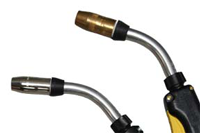
Aluminum necks are used on Bernard BTB air-cooled MIG guns.

Flexible necks are an available option for Bernard BTB air-cooled MIG guns.
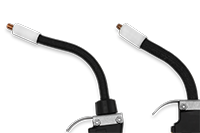
Gasless necks are used on Bernard Dura-Flux self-shielded flux-core guns.

Black polymer necks are used on Bernard TGX air-cooled MIG guns.

Black neck shrouds are used on Bernard Clean Air fume extraction MIG guns.
Don’t see your product here? Please contact our Technical Support team for assistance.

Bernard W-Gun water-cooled semi-automatic MIG guns can be identified by their brass colored neck and yellow trigger.
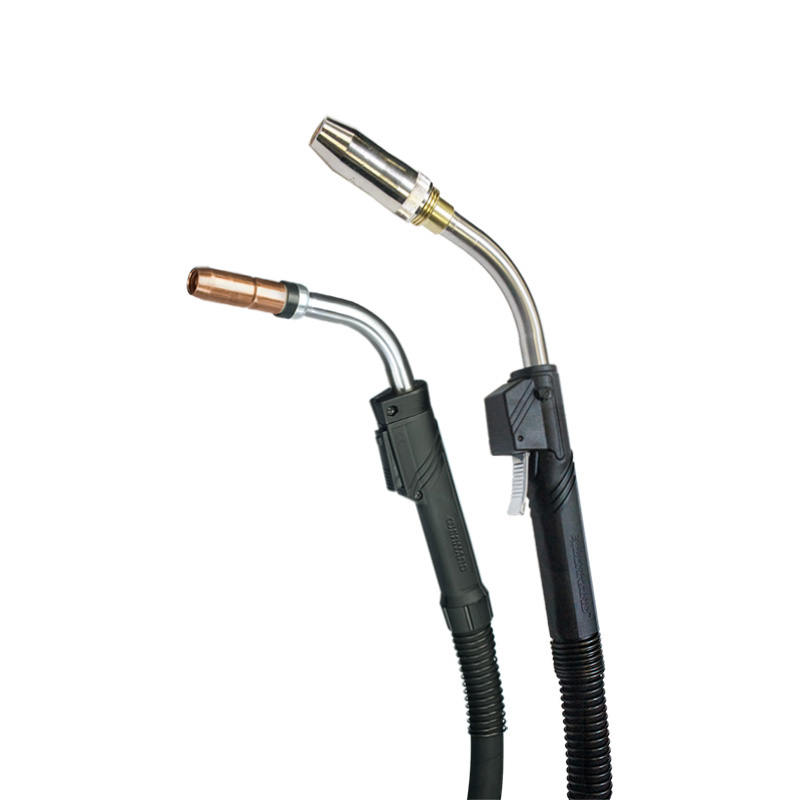
Bernard T-Gun water-cooled semi-automatic MIG guns have aluminum necks and either a black or silver trigger.
Don’t see your product here? Please contact our Technical Support team for assistance.
How is your robotic welding gun cooled?
If your MIG gun runs EXTERNAL to your robot arm, you have a TOUGH GUN CA3 Robotic MIG Gun.

If your MIG gun runs INTERNAL to your robot arm, you have a TOUGH GUN TA3 Robotic MIG Gun.
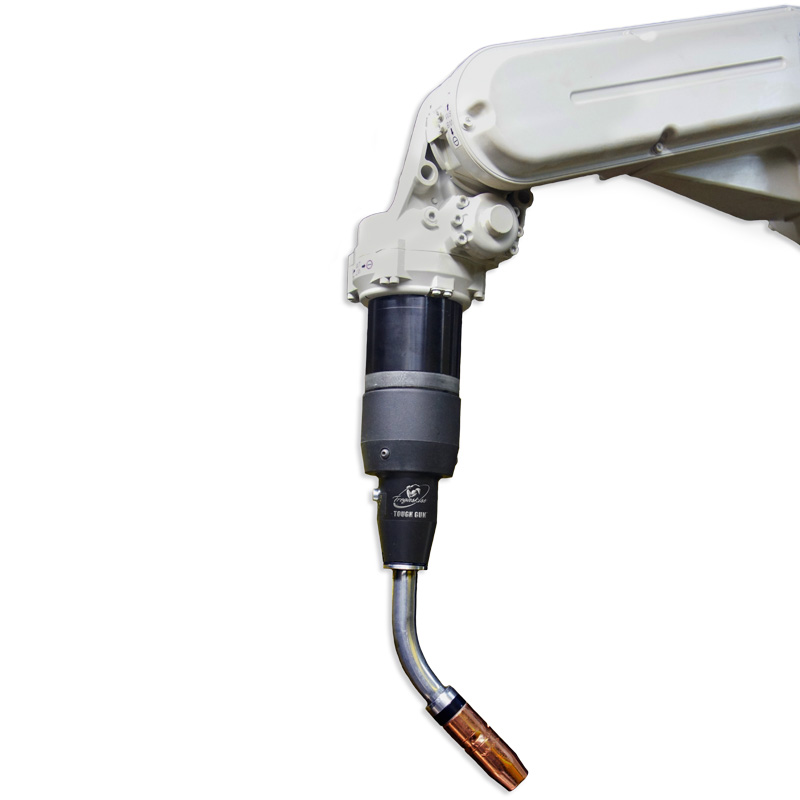
Don’t see your product here? Please contact our Technical Support team for assistance.
You have a Tregaskiss 600A Robotic Water-Cooled MIG Gun.
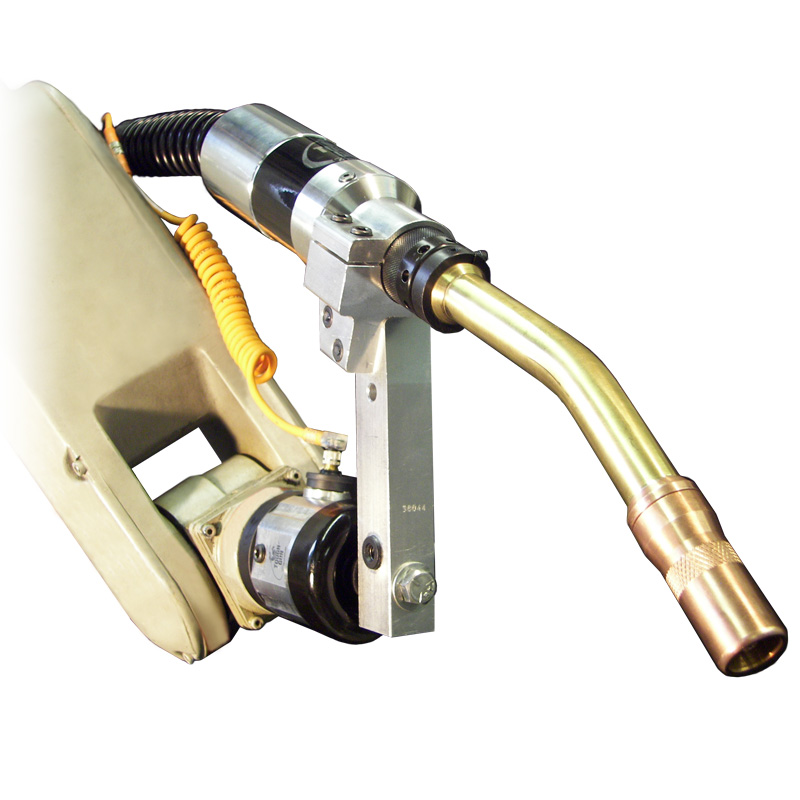
Don’t see your product here? Please contact our Technical Support team for assistance.
If your MIG gun runs EXTERNAL to your robot arm, you have a TOUGH GUN CA3 Robotic MIG Gun with I.C.E. technology.

If your MIG gun runs INTERNAL to your robot arm, you have a TOUGH GUN TA3 Robotic MIG Gun with I.C.E. technology.
Don’t see your product here? Please contact our Technical Support team for assistance.
You have Tregaskiss Fixed Automatic MIG gun. Which of the following does your product look like?

MW1 water-cooled fixed automatic MIG gun – note the thicker cable, brass nozzle retainer and silver brazed nozzle
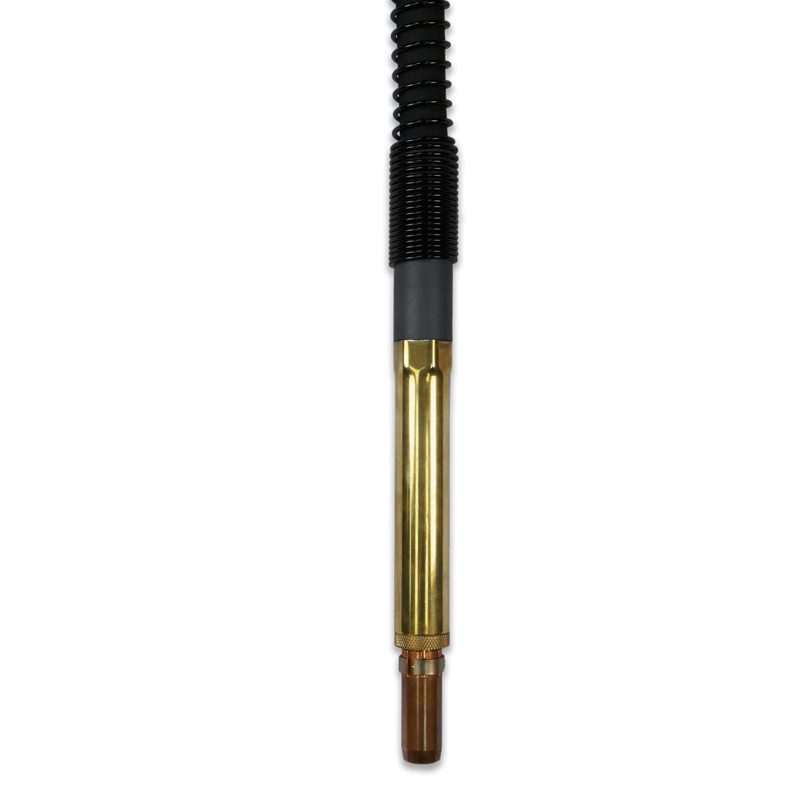
AW2 fixed automatic MIG gun – note the brass colored neck
Don’t see your product here? Please contact our Technical Support team for assistance.
NEW TOUGH GUN TT4A and TT4E reamers can be visually identified from the outside as follows:
TOUGH GUN TT4E (Ethernet) Reamer
Legacy TOUGH GUN TT3 and TT3E reamers can be visually identified from the outside as follows:
TOUGH GUN TT3E (Ethernet) Reamer
The easiest component to help you identify which consumables series is installed on your MIG gun(s) is your contact tip. Please compare your contact tip to the images below and follow the link to learn more.
Don’t see your product here? Please contact our Technical Support team for assistance.
We have aluminum liner options that work with most of our consumable series. Please click on one of the spec sheets below to access this information:
If you’d like to discuss your aluminum liner options, please contact our Technical Support team for assistance.
The brass end on your liner is unique to each liner series. Please compare your liner’s brass end with the images below:
Don’t see your product here? Please contact our Technical Support team for assistance.
Don’t see your product here? Please contact our Technical Support team for assistance.
If you require a CAD model of your robotic gun setup for simulation purposes, our Technical Support team can usually provide the files you need within 2 business days. Please note that only CAD models for complete systems can be provided. CAD models for individual parts and components are unavailable.
All requests are fulfilled to the best of our ability with the information given.
Check in regularly or subscribe to stay up-to-date on the latest Bernard® and Tregaskiss® product updates, improvements, discontinuations and new product information.
Search our Tech Connection Product News only
If you need assistance or have questions about your Bernard or Tregaskiss products, we’re here to help.
Phone: 1-855-MIGWELD (644-9353)
Email: cs@itwmig.com
Our Customer Service department can be reached by phone or email from 7:00 a.m. to 4:30 p.m. CST Monday through Friday to assist with:
Phone: 1-855-MIGWELD (644-9353), Option #3
Semi-Automatic Product Support: ts@bernardwelds.com
Automation Product Support: ts@tregaskiss.com
Our Technical Service team is ready to answer your technical support questions from 7:00 a.m. to 4:30 p.m. CST Monday through Friday. This team provides the following services to support customers both pre- and post-sale:
We will respond to all questions as soon as possible, but please note that it could take up to 2 business days to respond to inquiries submitted via email.
Your welding distributor is also a comprehensive resource for welding and cutting information and process or equipment troubleshooting. Distributors can help you choose the products and accessories that are right for you and your specific application. To locate a welding distributor in your area, visit Where To Buy.
If you search by configured gun part number, it will send you to the product page where you can access your manual in the right sidebar under Documentation.
If you search by product name or replacement component part number using this link, our search tool will return all PDF manuals that are a match. The search tool conducts a full body text search of our PDF manuals.
If you are unsure of your product name, use the “Help me identify my Tregaskiss or Bernard product” tool.
Having your configured gun or reamer part number will allow you to access a customized parts breakdown for your product online. If that is not available, the parts breakdown in your product manual is your next best resource.
Search by configured gun part number or use our menu system to access your product’s main page. From there, click on the Reverse Lookup button and enter your part number to generate a customized parts breakdown for your product.
Note: custom configurations beginning with SG or BTO are not accessible via these tools. Please contact Customer Service for assistance.
Search by product name to visit your product’s main web page. Under Documentation on the right sidebar, view the Parts Breakdown in your product’s manual.
If you are unsure of your product name, use the “Help me identify my Tregaskiss or Bernard product” tool. Then you can search by product name to visit your product’s main web page. Under Documentation on the right sidebar, view your Owner’s Manual and the Parts Breakdown it contains.
Search by product name to visit your product’s main web page. On the right sidebar under Documents, view your product’s owners manual. Under How Tos, watch videos or read webpages on how to maintain your product.
You can also search our How To documentation using the name of your product to access materials.
Safety instructions are located in every Bernard® and Tregaskiss® MIG gun owners manual. To find the owners manual for your Bernard or Tregaskiss MIG gun, refer to the above “Where do I find my product manual?” or click here.
View our safety instructions online or download them in PDF format.
Contact us ahead of your next tradeshow or event to secure the use of Tregaskiss® robotic, fixed automatic, or cobot MIG welding guns, robotic nozzle cleaning stations, and more — at no cost!
Fill out this convenient form to request robotic MIG gun and peripheral products for your event.
Learn more about welding automation, robotic MIG guns, welding consumables and more from our informative technical articles and case studies. To have new articles delivered to your inbox, please sign up for our Amperage e-newsletter.

Copyright 2024 Tregaskiss | All Rights Reserved

